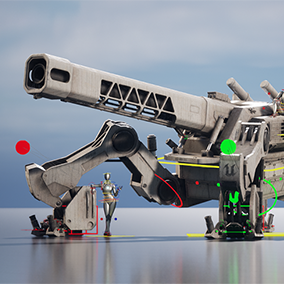HMI Design Challenge
This project provides a setup for creating virtual screens for a virtual car interior, allowing a designer to quickly create an interior for their HMI design. For the Contest, we also provide a sequencer cinematic to create the submission video.
- Supported Platforms
- Supported Engine Versions4.27
- Download TypeAsset PackThis product contains an assortment of Unreal Engine assets which can be imported into a pre-existing project of your choice.
Description
Unreal Engine has been used to build rich and detailed worlds with beautiful visuals, living motion, effects, and interaction. What might be possible for an HMI?
This template project provides the basic building blocks for a visual design prototype where there are no creative restrictions. The focus is to create a visual example of what the next generation HMI might look like. The template assets were built as a guide to get started, but we encourage anyone to step out beyond those bounds. You can tell the story of what a future HMI should be.
The demo scene includes a basic HMI layout in a simplified vehicle interior. There are example blueprints which either handle the content to be rendered, or create a virtual screen for the content to be viewed. The pair of blueprints reference each other directly, which links specific content to a single virtual screen. The content for each render target actor can be mixed 2D and 3D, use its own assets and lighting, and perspective – there are no rules for what the content might be!
Also included is a simple blueprint which emulates vehicle driving data. This sort of data can be referenced to build reactive assets such as gauges and visualizations.
For those participating in the HMI Design Challenge, your submission will be a video file recording of the HMI in the context of the vehicle interior. Included with the project is a sequencer file which can be used for exporting the video frames. Camera animation and framing may be adjusted, but overall length should remain under 60 seconds.
UE-Only Content - Licensed for Use Only with Unreal Engine-based Products
Technical Details
Features:
RT_Example Map:
This map provides a quick overview. There are several examples of screen configurations. The Vehicle Stage map has these concepts in context.
Vehicle Stage Map:
This map provides a few examples of HMI on simulated screens. It includes a data stream sequence and blueprint for simulating vehicle data, and visuals which react to it.
Screen Placer BP:
With this BP you place a virtual screen in the 3D space to represent a physical screen in a vehicle. Each screen placer linked to a unique RT Group blueprint.
RT Group:
BP_RTGroup is responsible for handling the camera and render target which is then displayed on the corresponding screen placer. It has variables for influencing camera and render settings.
Data Handler BP:
Streaming vehicle data is handled with this blueprint. It is referenced and animated in a sequencer, then writes the data to be shared to other blueprints.
Look At Camera Manager BP:
This blueprint gives the user control of the camera angle at runtime. It is viewed through at the end of the demo sequence. Cameras and input can be configured in the details panel.
Number of Static Meshes: 49
Number of Skeletal Meshes: 2
Number of Materials and Material Instances: 101
Number of Textures: 7
Supported Development Platforms:
Windows: Yes
Mac: Yes
















